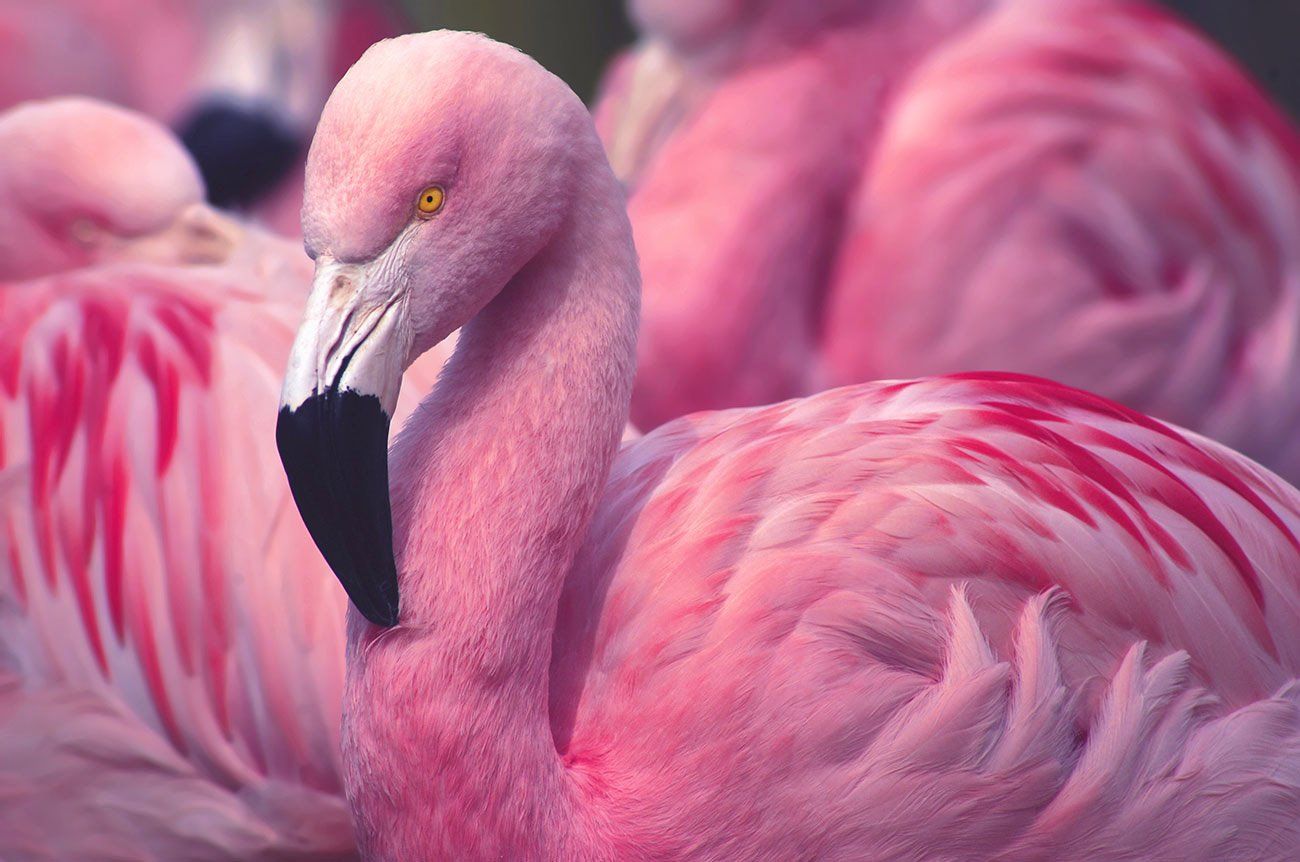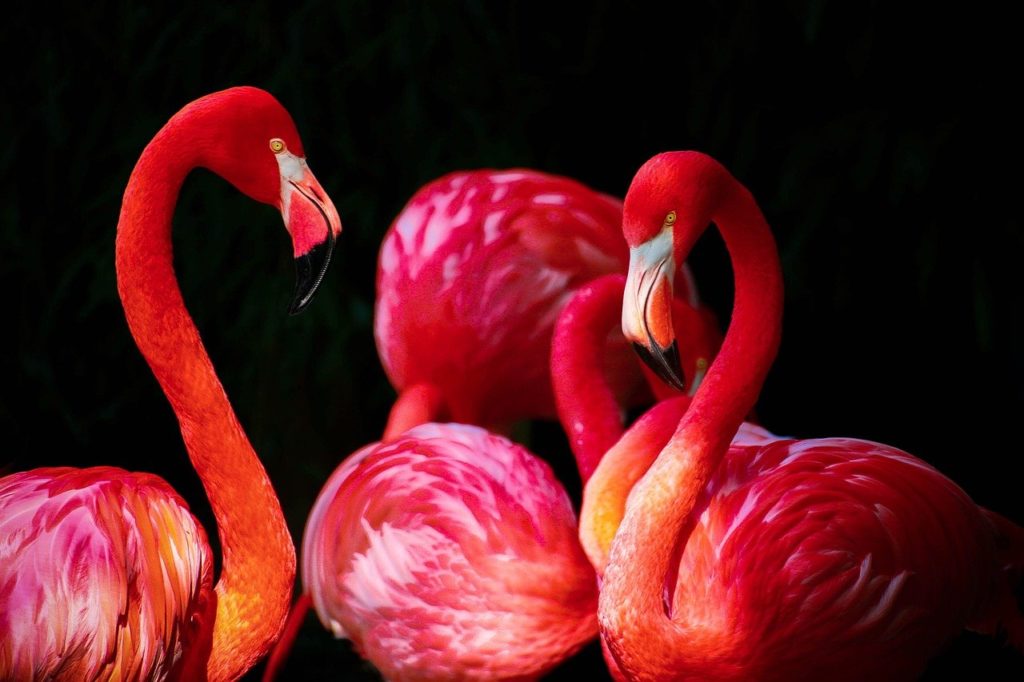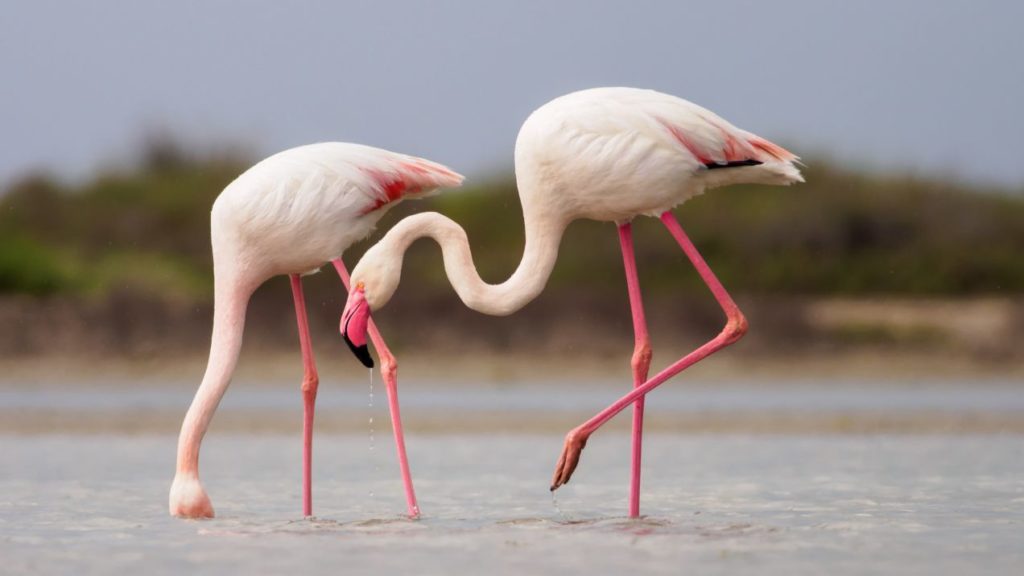
Phoenicopterus ruber
The most popular of the flamingos is the crimson flamingo inhabiting Central America. However, this is not the only area of their occurrence, they also inhabit Africa, Europe, and Asia. They are known for their characteristic one-legged posture in which they sometimes rest. Additionally, they fish for plankton in the water with an upturned head and nap by putting their head on the body.
Today, fortunately, they are not barbaric, but in ancient Rome they were killed for their tongues, which were considered a delicacy.
What do flamingos eat?
Flamingos mainly eat plankton. Their diet is diversified by small fish, crustaceans, and fly larvae. As a rule, they eat during the day.

Where do flamingos live?
Flamingos like to stay in warm climates. For this reason, they inhabit the hottest regions of the world – tropical, subtropical, and temperate areas of North and South America, the south-eastern part of Europe, Africa, and the south of Asia. They do not occur naturally in Australia. They can be found near lakes of various salinity levels, lagoons, and estuaries.
Why are flamingos pink?
Most of them are pink in color but are white or gray in nature. The pink color is the result of ingesting food rich in carotenoids.

***INTERESTING FACTS***
- Flamingos are associated with standing on one leg. For many years, scientists have wondered why. One of the theses said that in such a position they would run faster. This claim was refuted by American researchers. In fact, individuals standing on both legs were much faster. It was also believed that standing on one leg, the bird consumes much less energy. The most recent explanation is slightly different. While in the water, their body cools down quickly. They change legs from time to time to avoid chilling the body.
- Their body darkens just before the mating season. At their peak, they achieve the greatest saturation of pink.
- Under the tail of this bird there is a gland from which the flamingo takes special oil. She spreads it over her body during the mating season.
- The oldest specimens in the wild live up to 50 years. In captivity, they can live up to 80 years.
- There are 7 extinct species of flamingos.
- A row of flamingos is one that includes the various wading species that inhabit island zones where the climate is warm and hot. These are zones from all over the world, excluding Australia and Oceania.
- The most common habitats in which these birds most often and willingly inhabit are aquatic environments, such as salt and alkaline lakes, sea lagoons, salt pans, wetlands. Sometimes they are also found inland, but much less frequently.
- The body length of these birds ranges from about 80 cm to about 145 cm, but it should be noted that males are slightly larger than females.
- The feature of the appearance that is most peculiar and unique to these birds is the long neck and legs that are extended in flight.
- The appearance of the beak shows mainly what foods it has been adapted to. It is well suited, among others. for getting food from water.
- They are birds that migrate over short distances.
- Freshly hatched flamingos are whitish or gray with a straight red beak and pink legs.
- The vast majority of their plumage is pink.
- The flamingos that live in the Galapagos are different from those that live in the Caribbean.
- The eggs are kept under constant surveillance by at least one parent and hatch after 27 to 31 days.
- Because flamingos eat their food from salt water, and they drink seawater frequently.
- They are not in danger of extinction. Their population is estimated at 260 – 330 thousand. individuals.
- The beak of the young does not begin to curve until 11 weeks after hatching.
- During the mating season, males look for females, but females choose males.
- In addition to being good at flying, they can also swim, although swimming is usually the domain of younger individuals.
- Flamingos are herd animals. Thanks to this lifestyle, they are able to easily spot a predator and alert other individuals and encourage them to flee.
- Flamingos are migratory birds. They form long and uneven lines in their flight.
- They are birds that mate and last throughout their lives. They build silt domed nests in which they lay their eggs. They are usually one or two eggs from which the young hatch.
- After hatching, young flamingos form what are called nurseries. This behavior is also found, among others. at ostriches. Parents are able to recognize their young, which is necessary for their feeding.
- The largest individuals are pink flamingos. They are over 170 cm tall. They are most densely found near freshwater and marine waters in South and Central America, the Caribbean, Western Europe, South Asia, and parts of Africa.
- Flamingos are very social. They can be found in colonies of up to several thousand individuals. This way of life protects them from predators.
- The sounds they make are loud and deep (similar to the sounds of geese).
- A characteristic feature of flamingos is a long neck taking the shape of the letter “S”.
- The average height of flamingos is between 90 and 140 cm.
- Flamingos weigh between 2 and 4 kg.
- The egg laid by the female is incubated for 28 days. After hatching and feeding, the chick is protected by the parents.
- They have long and pointed wings.
- They can fly and swim well.
- The young are able to forage on their own after about 6-11 weeks.
- There are more plastic flamingos in the United States than there are real ones.
- Flamingos are extremely hardy. They stay at night in ponds that freeze overnight, drink boiling water and are resistant to poisonous gases.
- In Ancient Rome, flamingo tongues were considered a real delicacy.
- They eat upside down.
- Can fall asleep standing on one leg.
- Flamingos are monogamous and lay one egg each year.
- Their habitats are difficult to reach for predators.
- The feathers under the flamingo’s wings are black. You can only see them in flight.





















